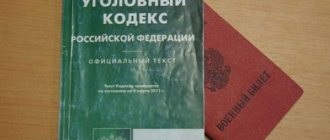ST 126 of the Criminal Code of the Russian Federation.
1. Kidnapping - punishable by forced labor for a term of up to five years or imprisonment for the same term.
2. The same act committed: a) by a group of persons by prior conspiracy; b) has become invalid; c) with the use of violence dangerous to life or health, or with the threat of such violence; d) using weapons or objects used as weapons; e) in relation to a known minor; f) in relation to a woman who is known to the perpetrator to be pregnant; g) in relation to two or more persons; h) for mercenary reasons - is punishable by imprisonment for a term of five to twelve years, with or without restriction of freedom for a term of up to two years.
3. Acts provided for in parts one or two of this article, if they: a) were committed by an organized group; b) has become invalid; c) caused by negligence the death of the victim or other grave consequences - shall be punishable by imprisonment for a term of six to fifteen years, with or without restriction of freedom for a term of up to two years.
Note : A person who voluntarily frees a kidnapped person is exempt from criminal liability unless his actions contain another crime.
Commentary to Art. 126 Criminal Code
The objective side of the crime is expressed in the actions of capturing (taking possession) and moving a person to another place for subsequent detention against his will. These actions can be carried out either secretly or openly, through the use of violence or other means, such as deception. Battering the victim is covered by the basic elements of kidnapping and does not require additional qualifications under Art. 116 of the Criminal Code.
2. The elements of kidnapping are formal; the crime should be considered completed from the moment of displacement, regardless of the time of detention.
3. The movement of a person for the purpose of committing another crime, for example murder or rape, does not require independent qualification under Art. 126 of the Criminal Code. Other cases of movement, for example, moving a person to another place with his consent, which no one knew about, also do not contain elements of a crime; taking possession and moving one’s own child against the will of the other parent (adoptive parent) or other persons with whom he was legally located, provided that the person acts in the interests of the child (Part 2 of Article 14 of the Criminal Code).
4. A preliminary conspiracy to kidnap (clause “a” of Part 2 of Article 126 of the Criminal Code) presupposes an agreement expressed in any form between two or more persons, which took place before the commencement of actions directly aimed at kidnapping.
5. The use of violence dangerous to life or health (clause “c” of Part 2 of Article 126 of the Criminal Code) involves such violence that resulted in the infliction of grave, moderate or slight harm to the health of the victim. The threat of violence presupposes the externally expressed intention of a person to cause death or harm to health of any degree to the victim. The victim can be either the kidnapped person or third parties who prevent the commission of a crime. The timing of the use of physical or mental violence does not matter (it can be used both during the abduction and during the detention).
6. The use of weapons or objects used as weapons (clause “d”, part 2 of Article 126 of the Criminal Code) means the use of any type of weapon classified as such in accordance with Federal Law of December 13, 1996 N 150-FZ “On weapons,” as well as other items with the help of which harm is caused or a threat is created to the victim.
7. Minors mean persons under the age of 18; this fact must be covered by the intent of the perpetrator (clause “d”, part 2 of article 126 of the Criminal Code).
8. The abduction of a pregnant woman (clause “e” of Part 2 of Article 126 of the Criminal Code) also presupposes knowledge of the perpetrator about this circumstance.
9. In accordance with the provisions of Part 1 of Art. 17 of the Criminal Code, the abduction of two or more persons, committed simultaneously or at different times, does not form a set of crimes and is subject to qualification only under paragraph “g” of Part 2 of Art. 126 of the Criminal Code.
10. According to clause “h”, part 2, art. 126 of the Criminal Code qualifies as kidnapping committed for the purpose of obtaining material benefits for the perpetrator or other persons or getting rid of material costs. If the theft is associated with a demand for the transfer of money or other property, then the act should be qualified under the totality of Art. 126 and 163 of the Criminal Code.
11. If the kidnapping is recognized as committed by an organized group (clause “a” of Part 3 of Article 126 of the Criminal Code), the actions of all participants, regardless of their role in the crime, should be qualified as co-perpetrator without reference to Art. 33 of the Criminal Code.
12. Other serious consequences include, for example, the victim’s suicide, his mental disorder, etc. If in relation to death the form of guilt can only be careless, then other grave consequences can be both intentional and careless (clause “c” of Part 3 of Article 126 of the Criminal Code).
13. According to the note to Art. 126 of the Criminal Code, the conditions for releasing a perpetrator from criminal liability are: a) voluntary release of the kidnapped person; b) the absence of other elements of a crime in the person’s actions.
if the heart cost less than 2,000 rubles
The assistance of a professional lawyer significantly increases the likelihood of a positive outcome of the case.
if the heart cost less than 2,000 rubles, then such an act can be recognized not as theft, but as petty theft, and then it falls under the Code of Administrative Offenses of the Russian Federation, which does not entail a criminal record.
In this case, the decisive factor is whether related actions were committed that entail criminal liability, regardless of the cost of the heart. For a list of such actions, see this link.
Administrative responsibility for heart theft
For the theft of a heart worth up to 1,000 rubles, the following liability is provided:
- a fine in the amount of up to five times the value of the stolen property, but not less than one thousand rubles;
- or administrative arrest for up to fifteen days;
- or compulsory work for up to fifty hours.
For the theft of a heart worth from 1000 to 2000 rubles, the following liability is provided:
- a fine in the amount of up to five times the value of the stolen property, but not less than three thousand rubles;
- or administrative arrest for a period of ten to fifteen days;
- or compulsory work for a period of up to one hundred and twenty hours.
Legislative regulation
Article 7.27 of the Code of Administrative Offenses of the Russian Federation, petty theft (version current for 2021)
1. Petty theft of someone else’s property, the value of which does not exceed one thousand rubles, by theft, fraud, misappropriation or embezzlement in the absence of signs of crimes provided for in parts two, three and four of Article 158, Article 158.1, parts two, three and four of Article 159, parts two, three and four of Article 159.1, parts two, three and four of Article 159.2, parts two, three and four of Article 159.3, parts two, three and four of Article 159.5, parts two, three and four of Article 159.6 and parts of the second and third of Article 160 of the Criminal Code of the Russian Federation, with the exception of cases provided for in Article 14.15.3 of this Code - (as amended by Federal Law dated 02/05/2018 N 13-FZ)
punishment: entails the imposition of an administrative fine in the amount of up to five times the value of the stolen property, but not less than one thousand rubles, or administrative arrest for up to fifteen days, or compulsory labor for up to fifty hours.
2. Petty theft of someone else’s property worth more than one thousand rubles, but not more than two thousand five hundred rubles through theft, fraud, misappropriation or embezzlement in the absence of signs of crimes provided for in parts two, three and four of Article 158, Article 158.1, parts two, three and fourth article 159, parts two, third and fourth of article 159.1, parts second, third and fourth of article 159.2, parts second, third and fourth of article 159.3, parts second, third and fourth of article 159.5, parts second, third and fourth of article 159.6 and parts the second and third articles 160 of the Criminal Code of the Russian Federation, with the exception of cases provided for in Article 14.15.3 of this Code - (as amended by Federal Law dated 02/05/2018 N 13-FZ)
punishment: entails the imposition of an administrative fine in the amount of up to five times the value of the stolen property, but not less than three thousand rubles, or administrative arrest for a period of ten to fifteen days, or compulsory labor for a period of up to one hundred and twenty hours.
Second commentary to Art. 126 of the Criminal Code of the Russian Federation
1. The main direct object of the crime is social relations that ensure a person’s right to freedom of movement and choice of place of stay (residence). In qualified compositions, an additional object is social relations that ensure the inviolability of human life and health.
2. The act represents illegal actions consisting of depriving a person of freedom of movement and moving him in space. The sequence of these actions does not matter. The victim may first be moved in space, for example, under the influence of deception, and then deprived of his freedom (Resolution of the Presidium of the Supreme Court of the Russian Federation dated November 2, 2016 No. 124P16).
The crime is considered completed from the moment the victim is captured (imprisoned) and moved in space. The subsequent retention of the abducted person, as well as its duration, do not matter for qualification.
3. The subjective side is characterized by direct intent.
4. The subject of the crime is a person who has reached the age of 14 years.
5. Part 2 of the commented article provides qualifying characteristics.
Clause “a” qualifies as kidnapping committed by prior conspiracy of two or more persons, each of whom took direct part in depriving a person of freedom of movement and (or) in moving him in space.
Clause “c” qualifies the kidnapping of a person with the use of violence, which created a real danger to the life or health of the victim or resulted in the infliction of grave, moderate or minor harm to health, or with the threat of the use of such violence.
Clause “d” qualifies the kidnapping of a person using any type of weapon (firearms, cold steel, gas, throwing and pneumatic) or objects used as weapons (for example, a kitchen knife).
Clause “d” qualifies the kidnapping of a person by a person who reliably knew about the minor age of the victim.
Clause “e” qualifies the kidnapping of a person by a person who reliably knew about the state of the victim’s pregnancy.
Clause “g” qualifies the kidnapping of two or more persons, either simultaneously or at different times, provided that the perpetrator has not previously been convicted of any of these kidnappings.
Clause “h” qualifies as kidnapping committed for the purpose of obtaining material benefits or avoiding material costs.
6. Part 3 of the commented article provides for special qualifying characteristics.
Clause “a” qualifies as kidnapping committed by an organized group (see Part 3 of Article 35 of the Criminal Code).
Clause “c” qualifies the kidnapping of a person, which through negligence resulted in the death of the victim (for example, the kidnapped person is suffocating in the trunk of a car or due to a gag in the mouth) or other serious consequences (for example, the suicide of the kidnapped person).
7. The note to the commented article provides a special basis for exemption from criminal liability. A person who frees a kidnapped person when there is a real possibility of detaining him is subject to release from criminal liability, unless his actions contain another crime.
Unlawful imprisonment
With this offense, a person is limited in his movement and remains in the place where the crime was committed. The victim is not only deprived of the opportunity to leave his home, but also to contact people from it, and so on.
Corpus delicti
Composition, in this particular case, is a crime against a person, his rights and freedoms. The person against whom this act was committed loses his ability to work for the benefit of society. Such a crime acts against the interests of this society.
Methods of committing
It is important to remember that a criminal act in the form of unlawful deprivation of liberty is committed either through active actions or in a passive form (failure to implement a set of measures to prevent restriction of freedom).
Article 127 differentiates the crime according to the methods of its commission:
- With violent actions, if deprivation of liberty is associated with mental or physical violence.
- Without the use of violence - through deception or abuse of trust, as well as the helpless state of the victim.
To prevent unauthorized deprivation of a person's freedom, there are two types of activities:
- to establish control over behavior under complete or partial restriction of freedom;
- to maintain control over the victim.
A crime will be considered committed if a person intentionally commits one of the above violations.
Object and Subject
The object of this act is the physical freedom of a person. She is the one who is being assassinated.
Objective characteristics determine the objective side of the crime and create the whole picture of the act and the details of its commission:
- the fact of holding a person without his consent;
- a place to hold the victim;
- duration of the crime;
- conditions of detention;
- factors relevant to the case as evidence.
The subject is the criminal who committed the act, who has reached the age of 16 and is of sound mind. The subjective side - goals, motive, etc., are capable of revealing the circumstances of the crime and what led to it.
Punishment for committing
If the act is committed without other factors, then the punishment will be:
- Restriction of freedom for 3 years.
- Arrest from 3 to 6 months.
- LS up to 2 years.
If there are aggravating circumstances, then the following penalties are imposed:
- LS from 3 to 5 years.
- In case of causing grievous harm or death without intent of the criminals - from 4 to 8 years LS.
When imposing a sentence, all aggravating and mitigating circumstances are taken into account.
Composition of the crime (kidnapping)
An act can be classified as a criminal offense only if it has all of the four necessary components:
- an object;
- objective side;
- subject;
- subjective side.
The object of this act is the physical freedom of people. It does not matter how old the person is, his gender, race, or other individual characteristics. Additionally, a crime can harm the life or health of people, so they are classified as an additional object.
The second mandatory element of the composition should be noted the objective side, that is, directly actions aimed at illegally depriving a person of freedom without his consent and it includes the following signs of kidnapping:
- Obtaining the opportunity to detain a person;
- Moving a person to a predetermined place;
- Unlawful retention;
According to the concept of this act, responsibility for the kidnapping of a person occurs even if the kidnapper completed only the first stage, that is, from the moment of illegal seizure. It is then that the act can be considered completed. In this case, the detention can be open or closed, and also carried out with the help of deception.
Important! The voluntary consent of a person to deprive him of his freedom excludes the elements of a criminal offense from the actions of the thief.
Also, actions will not be qualified as kidnapping if the subject of the commission is one of the child’s parents and if he illegally deprived the child of freedom in order to protect the interests of the kidnapped person. A parent deprived of parental rights is no exception.
Punishment for this offense begins at the age of 14 if the convicted person is sane.
Only acts committed with direct intent for the purpose of illegally depriving a person of freedom, regardless of the motive and purpose, fall under the criminal article.
What is kidnapping according to the letter of the law?
Art. is dedicated to Kidnapping. 126 of the Criminal Code of the Russian Federation. It defines kidnapping as the secret or open seizure of the freedom of another citizen, his further transportation, and detention in a place chosen by the criminals.
The crime is considered committed at the moment when the person is removed and moved to another place. If false imprisonment fails, it is attempted kidnapping. To qualify the act, it does not matter what methods the attackers used (violence, persuasion, deception, abuse of trust), or how long the injured citizen stayed in his temporary shelter.
Judicial practice demonstrates that the most common motives for kidnapping are:
- self-interest;
- banal hooliganism;
- jealousy;
- desire for revenge.
The object of the crime committed is an action that consists of removing a person from the place where he was, depriving him of freedom of movement.








